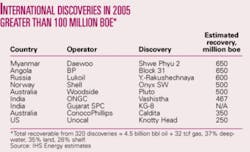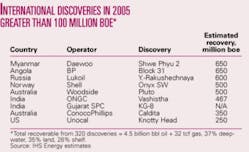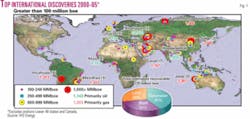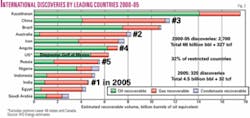No field with 1 billion boe recoverable is confirmed to have been discovered in 2005, but the world’s operators more than replaced the year’s production by bringing previously discovered fields on production and revising reserves upward in existing fields, IHS Energy reported.
The average world new field discovery size appears to have declined again in 2005, said Sandy Rushworth, IHS senior global data advisor. Potentially producible volumes from world discoveries in 2004 and 2005 were the lowest since World War II, Rushworth said.
More than 300 elephant sized prospects, each of which could hold 250 million bbl of oil equivalent or more, are on the books of the major oil and gas exploration companies for 2006-07, she told a forum sponsored by IHS preceding the 2006 North American Prospect Expo in Houston. Even this many prospects may not be enough to yield a significant volume of hydrocarbons for 2006.
Reserves figures used here are early estimates by IHS engineers of proved and probable reserves.
World discoveries
IHS Energy logged 2,700 discoveries in the 6 years 2000 through 2005 that contain a combined 120 billion boe of proved and probable reserves (Fig. 1).
The 2005 figure is 320 discoveries that total 4.5 billion bbl of oil and 32 tcf of gas, or 9.8 billion boe.
By far the largest volumes of hydrocarbons in the 6 years were discovered in Kazakhstan, China, and Brazil (Fig. 2). India, Australia, and China dominated discovery volumes in 2005, Rushworth said.
Daewoo International Corp.’s Shwe Phyu discovery off Myanmar led the 2005 list with the gas equivalent of 650 million bbl of oil (see table).
None of the five oil discoveries on deepwater Block 31 off Angola was a giant by itself, but together they equaled Shwe Phyu’s size.
India discoveries included ONGC’s 467 MMboe Vashistha find in the Krishna-Godavari basin and Gujarat State Petroleum Corp.’s KG-8 discovery, for which estimates have varied widely but which is being delineated this month.
OAO Lukoil’s recent discovery in the Russian Caspian is estimated to contain 600 million boe recoverable.
The table omits two 2005 discoveries in western China believed to be larger than 150 MMboe each.
IHS estimates of average discovery size, which are updated as time passes, are 800-900 MMboe in 1925-50, 240-300 MMboe in 1950-80, and 47-80 MMboe in 1980-2004.
Outlook for discoveries
Fewer licensing opportunities are in the offing for 2006 than 2005, but this could change, Rushworth pointed out.
Only 26 countries have announced bid rounds/lease sales so far for 2006, but 41 countries offered acreage opportunities last year.
This early in 2006 not all countries have published their bid blocks, and it is not clear whether more or less acreage will be made available.
Through scouting, IHS has become aware of 300 so-called “elephant prospects” that have combined recoverable volumes of 107 billion boe. Of these, 75% are oil prone. Potential at each is 250 MMboe or more.
The prospects are in 71 countries and under the control of 91 operators. They are 58% in Tertiary plays and 22% in Cretaceous plays.
Industry’s success rate in 2005 was 6%, or 10 successes of 250 MMboe or greater out of 140 elephant prospects identified.
The 9.8 billion boe that those exploratory wells discovered would translate to combined discovery of 6.42 billion boe in 2006 if operators maintain the 6% success rate, Rushworth said.
NOC challenges
The rise of national oil companies in the Far East has begun to pose challenges to western oil companies in obtaining acreage.
NOCs may have lower economic thresholds and may get special treatment by bidding local country content such as large downstream development. This was apparent in Nigeria and in Libya’s second licensing round, said Rushworth, who has 25 years’ experience as an exploration geoscientist with former Amoco and Texaco.
NOCs often have other advantages over oil and gas companies such as political connections, access to cheaper capital, a country’s internal need to obtain oil and gas supplies, and willingness to take lower internal rates of return. ✦





